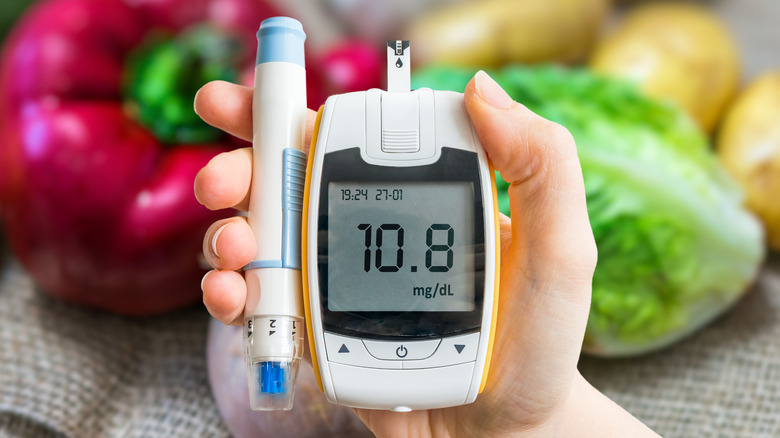Signs Of Metabolic Syndrome You Shouldn't Ignore
As described by the Cleveland Clinic, metabolic syndrome is a group of several risk factors that occur together and raise the risk of heart disease, stroke, and type 2 diabetes. The five major risk factors of metabolic syndrome are high blood pressure, elevated blood sugar, abdominal obesity, high triglycerides, and low levels of HDL cholesterol. Certain cancers (e.g., kidney, gallbladder, colon, prostate, liver), eclampsia, non-alcoholic fatty liver disease (NAFLD), liver fibrosis, cirrhosis, and cognitive decline are also associated with metabolic syndrome, reports the NIH.
Metabolic syndrome mainly results from body fat accumulation, which in turn drives insulin resistance. In fact, per UpToDate, metabolic syndrome is also referred to as insulin resistance syndrome. Treatment of metabolic syndrome focuses on controlling the individual risk factors (e.g., high blood pressure, high blood sugar) contributing to the condition while lifestyle changes (e.g., diet, exercise) are encouraged to mitigate or eliminate underlying contributors such as excess body fat and inactivity.
In a 2020 study published in The Journal of the American Medical Association, National Health and Nutrition Examination Survey (NHANES) data from 2011 to 2016 revealed that about 1 in 5 young adults (20-39 years old) and close to half of those aged 60 and over have metabolic syndrome. The overall prevalence of metabolic syndrome increased only marginally from 2011 to 2016. However, significant increases were observed among women (from 31.7% to 36.6%), adults aged 20-39 years (from 16.2% to 21.3%), Asian adults (from 19.9% to 26.2%) and Hispanic adults (from 32.9% to 40.4%).
Causes of metabolic syndrome
According to a 2022 review of studies in the International Journal of Molecular Sciences, insulin resistance is a hallmark of metabolic syndrome, playing a causal role in the development of each of the five major risk factors. While some people may be genetically prone to insulin resistance, excess body fat is the primary catalyst (via the NIH).
Normally, in response to the rise in blood sugar that occurs after a meal, the pancreas secretes insulin, enabling the uptake of glucose into liver, muscle, and fat tissues. Insulin also acts to block the release of fatty acids stored in fat tissue. However, when a person is insulin resistant, the target tissues stop responding to the insulin signal, causing blood glucose levels to rise. To compensate for impaired insulin signaling, the pancreas goes into overdrive, pumping out more and more insulin in an attempt to maintain normal blood glucose levels. In addition, resistance to insulin in fat tissues increases levels of free fatty acids in the blood, which accumulate in the liver and contribute to abnormal fat metabolism characterized by high triglycerides and low HDL cholesterol.
Insulin resistance is also linked to high blood pressure. In people who are not insulin resistant, insulin acts to dilate blood vessels which helps maintain normal blood pressure. However, in insulin-resistant individuals, this function is impaired, contributing in part to high blood pressure. The fifth component of metabolic syndrome, abdominal obesity, is tied to elevated levels of insulin resulting from insulin resistance (via the Cleveland Clinic).
Signs of metabolic syndrome to watch for
Signs or symptoms of metabolic syndrome are usually associated with one or more of the five major risk factors, reports the National Heart, Lung, and Blood Institute (NHLBI). While an expanding waistline is unmistakable, people with high blood sugar (hyperglycemia) may experience blurred vision, increased thirst, increased urination (particularly at night), fatigue, and weakness. Other signs of hyperglycemia include headaches, extreme hunger, weight loss and irritability (via Medical News Today).
For the most part, there are no signs or symptoms for high triglycerides, low HDL, and high blood pressure, conditions that are typically detected through routine testing (via the NHLBI). Nevertheless, per the NIH, some individuals with very high levels of triglycerides may have abdominal pain, pancreatitis, and short-term memory loss. Moreover, low HDL has been linked to depression (per a 2019 study in Lipids in Health and Disease). Warning signs of extremely high blood pressure include severe headache, nosebleed, vision issues, fatigue, confusion, chest pain, shortness of breath, abnormal heartbeat, blood in the urine, and throbbing in the chest, neck, or ears (via WebMD). Flushing of the face, dizziness, anxiety, sweating, and insomnia may also cause blood pressure to spike.
As noted by the Cleveland Clinic, metabolic syndrome can also be spotted through signs of insulin resistance, its underlying disorder. Insulin resistance can be recognized by acanthosis nigricans (patches of darkened skin in the armpit or back and sides of the neck), skin tags, and vision changes.
High blood pressure
According to a 2014 review published in Diabetology & Metabolic Syndrome, high blood pressure (hypertension) is closely tied to insulin resistance, the predominate feature of metabolic syndrome. Roughly half of people with hypertension have high blood levels of insulin, a compensatory response by the pancreas to insulin resistance. Also, hypertension occurs in up to 80% of people with type 2 diabetes, which is synonymous with insulin resistance. When hypertension and insulin resistance occur together, the risk of developing cardiovascular disease and type 2 diabetes is markedly increased. Chronic low-grade inflammation appears to be a common denominator underlying all these conditions.
Insulin resistance appears to induce hypertension through several mechanisms, per a 2015 study in Kidney International. For example, insulin plays a role in regulating blood pressure by stimulating the reabsorption of sodium by the kidneys. However, high blood levels of insulin resulting from insulin resistance cause increased sodium reabsorption and subsequent water retention, leading to higher blood pressure. Another mechanism involves the constriction of blood vessels caused by insulin resistance. Since greater force is needed for blood to flow through narrowed vessels, blood pressure rises.
Interestingly, per the 2014 review, insulin resistance and hypertension favored our primitive ancestors by helping them survive famine, infection, and trauma. Insulin resistance allowed redirection of nutrients to the brain, fetus, and immune system, whereas hypertension increased blood flow to the brain during famine and to the fetus during pregnancy. However, in modern times of food abundance, the occurrence of these two conditions on a chronic basis leads to metabolic syndrome.
High blood sugar
As described by the Cleveland Clinic, another major feature of metabolic syndrome is elevated levels of blood sugar (hyperglycemia). In people with metabolic syndrome, the body's cells become resistant to the action of insulin in signaling the uptake of glucose from the blood. This leads to high levels of blood glucose which, if sustained over time, can lead to prediabetes and type 2 diabetes. Alarmingly, prediabetes affects approximately 1 out of every 3 American adults.
Per the NIH, chronic hyperglycemia can cause serious damage to various tissues and organs throughout the body, including the nerves, eyes, and blood vessels. If not controlled, this toxicity of excess glucose can eventually lead to complications such as nerve damage, poor wound healing, cerebral vascular disease, and chronic kidney disease. Among the mechanisms by which glucose mediates its toxic effects are oxidative stress, inflammation, and glycation (via a 2019 review in the International Journal of Physiology, Pathophysiology and Pharmacology). Chronically elevated levels of blood sugar induce the production of unstable, reactive molecules called free radicals which, in high concentrations, can inflict significant damage (oxidative stress) to cell structures. Oxidative stress resulting from high blood sugar promotes a state of systemic inflammation which, in turn, stimulates the production of more free radicals and a vicious cycle ensues.
The third mechanism, glycation, occurs when sugars bind to proteins in the body and form advanced glycation end-products (AGEs). AGEs cause structural and functional impairment of proteins, a process accelerated by chronically high blood sugar.
Abdominal obesity
Visceral fat (or belly fat) is fat stored deep inside the belly, surrounding the abdominal organs (via WebMD). This hidden type of fat is more dangerous to your health than the subcutaneous fat located beneath the skin.
As noted in a review published in BMC Sports Science, Medicine and Rehabilitation, among the five major risk factors for metabolic syndrome, abdominal obesity is regarded as the first and foremost. Fat that accumulates within the abdomen is associated with the development of insulin resistance. Visceral fat is composed of fat cells that are enlarged and dysfunctional, sometimes described as "sick fat." Rather than simply being a stockpile of fat globules, sick fat is biologically active, secreting proinflammatory cytokines (e.g., TNF-alpha, interleukin-6) and contributing to systemic inflammation. Ultimately, abdominal fat stimulates insulin resistance and chronic systemic inflammation, as well as oxidative stress (free radical damage), all driving forces behind the metabolic syndrome.
While an expanding belly could also be caused by subcutaneous fat, a potbelly or "apple-shaped" (versus "pear-shaped") belly is more suggestive of too much visceral fat, explains the Cleveland Clinic. Comprising roughly 10% of total body fat, visceral fat is primarily associated with excessive consumption of carbohydrates (sugars) and inactivity. High levels of cortisol due to stress can also cause more visceral fat to pile up. Fortunately, visceral fat is easier to burn than subcutaneous fat. The ideal strategy for reducing visceral fat is to adhere to a healthy lifestyle that includes fewer refined carbohydrates, exercise, and stress management.
Low HDL cholesterol
High-density lipoproteins (HDL) are particles composed of fat and protein that function as carriers and transporters of cholesterol through the bloodstream (via MedlinePlus). HDL, occasionally referred to as the "good" cholesterol," is cardioprotective because it picks up cholesterol molecules form arterial plaque and subsequently transports them to the liver for disposal. In contrast, low-density lipoproteins or LDL (the "bad" cholesterol) has a strong affinity for the lining of blood vessels and thus contributes to the development of plaque in the arteries.
In a 2015 population study in nearly 5,000 adults published in BMC Public Health, an increase in the incidence of metabolic syndrome correlated with a decrease in HDL over a 5-year period. Metabolic syndrome was less likely to occur in participants with high-normal and normal HDL versus those with higher levels of HDL. Notably, low HDL was determined to be an early sign of metabolic syndrome; thus, it is a critical preventable risk factor for metabolic syndrome and cardiovascular events such as heart attack and stroke.
Per Science Daily, HDL can be measured as either HDL-C or as HDL-P. HDL-P refers to the number of lipoprotein particles, whereas HDL-C represents the "cargo" of cholesterol loaded on the lipoprotein carriers. A 2017 study in Diabetes and Metabolic Syndrome: Clinical Research & Reviews found a significant association between low HDL-P and an increased risk of developing metabolic syndrome, independent of HDL-C. This is noteworthy because HDL-P has been previously demonstrated to be more powerful than HDL-C at predicting cardiovascular disease.
High triglycerides
Triglycerides are the most abundant type of fat stored in the body, reports Healthline. They can come directly from foods or be produced in the liver from consumption of excess calories that are not instantly burned for energy. The body stores triglycerides in fat cells for energy use when needed. A high level of triglycerides in the blood (hypertriglyceridemia) is usually caused by eating too many high-carbohydrate foods, especially sugars. High blood triglycerides increase the risk of atherosclerosis (narrowing of the arteries), as well as stroke, heart attack, and peripheral artery disease.
Per Medscape, elevated triglyceride levels in the blood is one of the five major risk factors of metabolic syndrome. In a 2020 population study in Lipids in Health and Disease, triglyceride levels increased in parallel with both insulin resistance and impaired beta cell function. While insulin resistance is synonymous with metabolic syndrome, impaired beta cell function (as well as insulin resistance) plays a role in the development of type 2 diabetes. Beta cells are the cells of the pancreas that make insulin (via Medical News Today). Impaired beta cells don't produce enough insulin to regulate blood sugar, which can lead to sustained levels of high blood glucose and greater risk of diabetes.
In another finding in the 2020 study, low levels of superoxide dismutase (SOD), the primary antioxidant in the body, correlated with both insulin resistance and high triglycerides. This suggests that low SOD may result in more oxidative stress, a key player in the development of metabolic syndrome.
Diagnosis of metabolic syndrome
Diagnosing metabolic syndrome begins with a thorough history and physical examination, notes the NIH. This is especially important for determining waist circumference and for recognizing physical signs of insulin resistance.
Atherosclerosis can be detected by arterial bruits (sounds of turbulent arterial blood flow), while high levels of blood fats can be spotted by the presence of xanthomas, fatty growths beneath the skin. Blood work is also an essential diagnostic tool, continues the NIH. Two of the five major risk factors for metabolic syndrome (low HDL and high triglycerides) are assessed with a lipid panel. Insulin resistance, type 2 diabetes, and kidney disease can be identified from a basic metabolic panel that includes hemoglobin A1c (i.e., average blood sugar over about 3 months). Additional blood tests that may be used to support a diagnosis of metabolic syndrome include liver and thyroid panels, uric acid, and C -reactive protein (CRP), a marker of systemic inflammation. Imaging studies and cardiac stress testing can evaluate heart problems, including high blood pressure.
Per the Mayo Clinic, an individual that meets three or more of the following criteria has metabolic syndrome: a waistline of 40 inches or more for men and 35 inches or more for women; blood pressure of 135/80 mm Hg (millimeter of mercury) or higher; a triglyceride level of 150 mg/dL (milligrams per deciliter) or higher; a fasting blood glucose (sugar) of 100 mg/dL or greater; and a high-density lipoprotein (HDL) below 40 mg/dL (in men) or 50 mg/dL (in women).
Lifestyle management of metabolic syndrome
Per the National Heart, Lung, and Blood Institute (NHLBI), the first line of treatment for metabolic syndrome is centered on healthy lifestyle changes, primarily involving diet and exercise. Lifestyle improvements can help prevent the progression of metabolic syndrome to more serious conditions.
The most important dietary recommendation is to reduce the quantity and improve the quality of carbohydrate foods (via Healthline). Eating carbohydrates exerts a direct effect on blood sugar and insulin levels, causing them to rise quickly. Over time, chronic overconsumption of carbs and consequent hyperglycemia reduces the sensitivity of your cells to insulin, leading to insulin resistance syndrome and increased risk of type 2 diabetes. Refined carbs and sugars (e.g., sodas, desserts, white bread, sweetened cereals) spike blood sugar and insulin and should be limited. Conversely, high-fiber foods (e.g., non-starchy vegetables, whole fruit, oatmeal, whole grain breads) blunt the rise in blood sugar and insulin and should be encouraged. Fish and other lean proteins. as well as healthy fats from olive oil, avocado, and nuts, are also favored. Among many other health benefits, these foods help to slow the rise in blood sugar and insulin following meals, thus moderating their blood levels.
Per the Mayo Clinic, regular exercise (at least 30 minutes daily) and stress management are also highly recommended. Together with a healthy diet, these lifestyle interventions can help promote weight loss. Weight loss that reaches 7% of body weight curbs insulin resistance and lowers high blood pressure and diabetes risk.
Medical treatment of metabolic syndrome
According to WebMD, medications may be indicated for metabolic syndrome when lifestyle measures alone are not sufficient to control the associated risk factors (hypertension, low HDL, high triglycerides, hyperglycemia, and abdominal obesity).
Medications used to reduce blood pressure include ACE inhibitors (Capoten, Vasotec), angiotensin II receptor blockers (Cozaar, Diovan), diuretics, and beta blockers. Low-dose aspirin may be suggested to lessen the chances of suffering a stroke or heart attack, particularly in those people at high risk for blood clots. Statin drugs (Crestor, Lipitor, Zocor) and niacin (vitamin B3) can lower triglycerides and increase levels of HDL cholesterol. As noted by the National Heart, Lung, and Blood Institute (NHLBI), some statins have adverse effects in people with metabolic syndrome, including an increased risk for type 2 diabetes. Supplementation with omega-3 fatty acids (fish oil) is another effective option for reducing blood levels of triglyceride. To help decrease high blood sugar levels, insulin sensitizers such as metformin are especially beneficial.
Other drugs may be prescribed to treat or minimize the risk of more serious complications of metabolic syndrome (e.g., diabetes, heart disease, kinder disease, or stroke).
Prognosis of metabolic syndrome
The primary long-term risk associated with metabolic syndrome is cardiovascular disease, notes Healthline. Accordingly, frequent medical check-ups are advised to monitor blood pressure and blood lipids and help avert a potential heart attack or stroke. While a healthy diet, exercise, and (if necessary) medications can help control symptoms, weight loss may even reverse the syndrome.
Apart from cardiovascular problems, several other conditions can develop as complications of metabolic syndrome (via Medscape). Among these conditions are type 2 diabetes, obstructive sleep apnea, psoriasis, and nonalcoholic fatty liver disease (NAFLD). A fatty liver also exerts a reverse effect by contributing to the development of metabolic syndrome. Cancers of the breast, colon, gallbladder, kidney, and prostate have also been linked to metabolic syndrome.
Additionally, an increased risk of recurrent preeclampsia occurs in women who have metabolic syndrome between pregnancies. Other conditions associated with metabolic syndrome include neuropathy and accelerated cognitive impairment.












